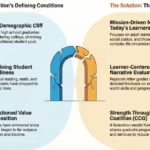Unlocking the transformative power of artificial intelligence as a pedagogical partner in modern universities and colleges.
Key Takeaways: The Future of AI-Powered Higher Education
- AI serves as a pedagogical partner that enhances rather than replaces faculty expertise
- Adaptive learning platforms provide personalized education at scale through data-driven insights
- Virtual teaching assistants offer 24/7 student support while freeing faculty for complex interactions
- Personalized content delivery addresses diverse learning styles and preferences
- Successful AI integration requires proper faculty training, support, and ethical guidelines
- The competitive advantage goes to institutions that thoughtfully blend AI innovation with human connection
Introduction: Embracing AI in Higher Education Without Losing Human Connection
In colleges and universities throughout the world, educators are weighing the promise of artificial intelligence in higher education against the apprehensions that many of us are experiencing. On one hand, most of us can see how AI tools for university faculty equip professors with powerful capabilities to tailor classroom prompts, examination questions, homework problems, and academic support to the unique needs of every student. On the other hand, we worry that computer-generated exam questions, auto-graded assignments, and canned feedback may distance professors from their students and undermine the trust that anchors healthy student-professor relationships.
As educational leaders, the issue is not whether AI will enter the academy—it already has—but how we will help our faculty and staff meaningfully integrate these transformative educational technologies into the learning environment.
Why AI Partnership Matters in Higher Education
As a three-time university president, I have seen that the most successful use of new academic tools happens when they are designed to enhance, refine, and elevate the faculty role. Therefore, I suggest that academic leaders position AI as a pedagogical partner that assumes select instructional duties and assessments so that professors can dedicate significantly more time to mentoring students and individually preparing them for the steps they take at and beyond college.
Used in this way, AI becomes less about replacing human judgment and more about strengthening the faculty-student connection that remains at the heart of a high-quality university experience. The challenge, of course—and the theme for an upcoming blog—is ensuring that faculty are given the training, support, and freedom to experiment with these tools in ways that fit their disciplines and teaching styles. When that happens, AI is not a threat to the professor but a partner that helps faculty cultivate rigorous and responsive learning environments.
Adaptive Learning Platforms: AI as a Partner in Instructional and Assessment Customization
What Are AI-Powered Adaptive Learning Systems?
One of the most promising applications of AI in education is the development of adaptive learning platforms. These systems draw from multiple streams of student data analytics to analyze how each individual learns and to adjust the pace, content, and assessment of instruction accordingly.
Three Types of Data Driving Personalized Education
Typically, adaptive learning platforms rely on three types of data:
- Student performance metrics on quizzes, tests, and assignments which reveals error patterns and mastery levels
- Student engagement indicators such as login frequency, time on task, and interaction history
- Student context information such as prior coursework, language proficiency, or accessibility needs
How AI Enables Personalized Learning at Scale
By integrating these data points, adaptive platforms customize learning in ways that reflect a student’s strengths and areas for improvement. Faculty can then focus their attention where it is needed most—serving as coaches in areas where students require development and as motivators in areas where students excel.
For example, in a first-year math class, the system might detect that one student struggles with algebraic formulas while another breezes through those but falters with applied word problems. The platform would then adjust supplemental instruction—offering tailored readings, videos, resources, or homework problems—to meet each learner where they are.
Importantly, the professor is not sidelined. Instead, the system becomes a partner in helping the instructor pitch problems at the right level, enabling students to build confidence and prepare for the next stage of their studies.
Virtual Teaching Assistants: AI as a Partner in Supplemental Assistance
24/7 Student Support Through AI Teaching Assistants
To extend faculty reach, AI can also offer 24/7 course-specific support through virtual teaching assistants (VTAs). One of the best-known examples is “Jill Watson,” created by Georgia Tech’s Design Intelligence Lab. At any time of the day or night, Jill responds to student inquiries about the class presentations, course videos and transcripts, textbook materials, and study guides associated with several online courses at Georgia Tech.
Students can log in from their computers or mobile devices, pose questions, and receive guidance drawn from instructor-approved courseware.
Research-Backed Evidence of AI Teaching Assistant
Emerging research shows “preliminary evidence that Jill Watson may support deeper understanding of the subject matter ….and that Jill positively impacts student performance.” These early results need to be explored further.
Even so, Jill’s presence highlights the way AI can serve as a partner who handles basic questions so faculty can devote more time to complex discussions that spark curiosity. Faculty can also spend more hands-on time mentoring students to ready them for disciplinary careers and graduate studies.
Read more about Georgia Tech’s breakthrough study on Jill Watson – an AI teaching assistant that successfully served 1,300+ students with 97% accuracy using ChatGPT and retrieval-augmented generation (RAG).
Personalized Delivery Modes: AI as a Partner in Multiple Modalities
Addressing Different Learning Styles with AI
Beyond adaptive platforms and virtual teaching assistants, AI can also align the delivery of instruction with the needs of different learners. Not all students absorb material most effectively through lectures or textbook readings. Some learn best through videos, visualizations, interactive puzzles, or simulations. Others benefit from narrative explanations, case studies, or collaborative problem-solving scenarios.
Smart Content Recommendation Systems
AI-powered systems can analyze engagement patterns and recommend formats—text, video, audio, or experiential activities—that resonate with a particular student. A classroom that incorporates these diverse modalities offers students more than one pathway to mastery, and AI becomes a partner in expanding access to those learning options.
A Partnership in Practice: Faculty and Administrators Guiding AI for Educational Good
The Future of AI-Enhanced Teaching
I cannot imagine that AI will replace professors in the near future. It is likely, though, that professors who completely shun AI will see lower enrollments than those who engage with it in thoughtful and ethical ways. In a competitive marketplace, serious students are drawn to courses that balance academic rigor with technological innovation.
Setting New Standards for Excellence in Higher Education
Faculty who learn to weave AI into their teaching without compromising human connection will not only maintain relevance but may also set new standards for excellence in higher education.
As I will discuss in a forthcoming blog, the duty of educational leaders is to prepare faculty for this work—positioning AI not as a threat to professors but as a partner in helping them do their best teaching.
Frequently Asked Questions About AI in Higher Education
How can AI improve student learning outcomes?
AI enhances student learning through personalized instruction, adaptive content delivery, and real-time feedback systems that adjust to individual learning patterns and needs.
What are some of the concerns about using AI in the classroom?
Common concerns include maintaining faculty-student connections, ensuring academic integrity, teaching students how to use AI ethically and responsibly, pinpointing misinformation or even “system biases,” protecting student privacy, and preventing over-reliance on automated systems.
How should universities prepare faculty for AI integration?
Universities should provide sophisticated training programs, create clear ethical guidelines, offer technical and research support, and encourage experimentation within established boundaries.
What types of AI tools are most effective for higher education?
Some of the effective AI tools include adaptive learning platforms, virtual teaching assistants, intelligent tutoring systems, and AI-powered content recommendation engines.
Will AI replace university professors?
Not likely. AI should be designed to augment and support faculty rather than replace them. An effective use of AI enables professors to focus on personalized mentoring, high-level critical thinking development, and individualized student guidance.
The transformation of higher education through artificial intelligence will not occur in the future—it’s happening now. Universities that embrace AI as a collaborative tool while maintaining their commitment to human-centered learning will lead the way in educational excellence.


